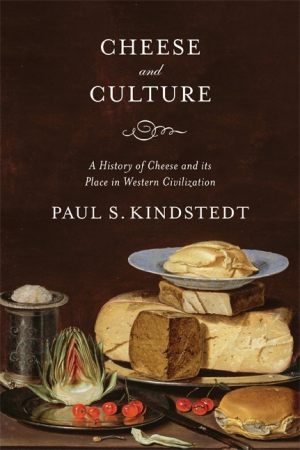
Cheese and Culture
A History of Cheese and Its Place in Western Civilization
Cheese, glorious cheese. Who knew the 9,000 years of innovation, lore, history, and romance in your story? Who knew skim milk cheeses initially flourished not for diet reasons, but because they were cheaper for London’s working-classes? That higher-temperature cooking techniques contributed to the development of dry and aged cheeses? Or that economics, religion, social mores, climate, and—well, nearly anything—has influenced the evolution of cheese in all its forms, styles, tastes, shapes, and uses? Paul S. Kindstedt knows, and now, through his impeccably researched, and carefully assembled book, any cheese lover can know, too.
Kindstedt, a professor of food science at the University of Vermont (oh, glorious cheese- making state!), co-author of the 2005 volume American FarmsteadCheese, and co-director of the Vermont Institute for Artisan Cheese, is certainly credentialed. But he’s also clearly passionate about his subject, parsing the history and intersection of cheese and culture into an intriguing narrative.
As he notes in the introduction, “a grand narrative binds all cheeses together into a single history, that started with the discovery of cheese making, and that is still unfolding.” Way beyond how man invented/discoveredcheese and why, readers get the most detailed backstory and a sense of how everything is connected; tension, conflict, flared tempers, and government interference/regulation also make frequent appearances, throughout the ages, countries, and cultures.
Kindstedt’s is a book written with scholarly rigor; yet, that detail-laden precision also makes it palatable for foodies curious about how and why food choices, production, and tastes have emerged over centuries—the person jazzed to learn, for example, that “Grated cheese seems to have occupied a special place in Greek culture” indicated by a wounded soldier being served “an elixir consisting of Pramnian wine on which (his slave) sprinkles goat’s-milk cheese, grated with a bronze grater,” or that the seasonal movement of cows across south-central France inspired techniques for producing longer-lasting mountain cheeses.
Like the range of cheeses available today, at times Cheese and culturecan be overwhelming, and the chapter on regulation reads like an alphabet soup of agency abbreviations and acronyms. But, like the veined or sharply flavored offerings on a cheese plate, one could choose to skip it and still be satiated.
Reviewed by
Lisa Romeo
Disclosure: This article is not an endorsement, but a review. The publisher of this book provided free copies of the book and paid a small fee to have their book reviewed by a professional reviewer. Foreword Reviews and Clarion Reviews make no guarantee that the publisher will receive a positive review. Foreword Magazine, Inc. is disclosing this in accordance with the Federal Trade Commission’s 16 CFR, Part 255.
